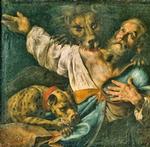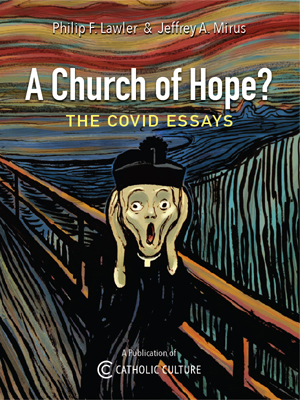New Doctors of the Church: St. Hildegard, St. John of Avila
By Dr. Jeff Mirus ( bio - articles - email ) | Oct 08, 2012
Yesterday Pope Benedict opened the Synod on the New Evangelization and declared two new doctors of the Church, St. John of Avila (1500-1569) and St. Hildegard of Bingen (1098-1179). Given the occasion, it is not surprising that both of these saints excelled in re-evangelizing—in stirring up and strengthening the faith of those who had already heard the Gospel.
St. John of Avila
St. John of Avila was born near Toledo in Spain to noble parents descended from conversos, Jews who had converted to Catholicism. At first he studied law at the University of Salamanca, but he soon returned home to live a life of austere piety. A visiting Franciscan priest recommended that he study philosophy and theology at the University of Alcalá, where he excelled and was ordained to the diocesan priesthood.
His parents died while John was a student. Hoping to be a missionary to America, he returned home and sold his estate. However, his piety and zeal were brought to the attention of the Archbishop of Seville, who pressed him to abandon his plan to go to America and instead to devote himself to reviving the faith at home, in Andalusia. Accordingly, he preached his first sermon in the summer of 1529, beginning a nine-year apostolate there before moving on to other regions in Spain.
All was not smooth sailing. Early on, St. John’s emphasis on the spiritual dangers of worldly possessions made enemies among the wealthy, leading some to denounce him to the Inquisition. He was quickly exonerated, however, and soon he was invited to preach at the Spanish Court. By his death on May 10, 1569, he was widely acknowledged as a formidable force for renewal. St. John also influenced St. Teresa of Avila, St. John of God, St. Francis Borgia, and Venerable Louis of Granada. His favorable disposition toward the Jesuits had a major impact on that Order’s expansion in Spain.
Interest in John of Avila’s sanctity has been very steady since his death. He was declared venerable by Clement XIII in 1799, beatified by Leo XIII in 1893, canonized by Paul VI in 1970, and has now been declared a Doctor of the Church by Benedict XVI in 2012.
St. John’s principal works are his Audi Filia (Hear, Daughter), a classic work on spiritual perfection written for a nun, and his spiritual letters to his disciples. See the links at the end.
St. Hildegard of Bingen
St. Hildegard of Bingen was born to a noble family in what is now Germany in 1098. She died as a Benedictine Abbess on September 17, 1179. Weak and sickly as a child, she had very little formal education. Her parents had promised her to God, so they put her in the care of a Benedictine nun in the Diocese of Speyer, who taught her to read and to sing the Divine Office. Hildegard was never taught to write, but she was loved and respected for her piety and holiness. When the nun who had taken her in charge died in 1136, Hildegard was elected superior.
In fact, Hildegard attracted many novices to the convent, leading to its rapid growth. Urged by what she perceived as a Divine command, she moved on with eighteen sisters in 1148 to found a new Benedictine house at Rupertsburg near Bingen. She also established a convent at Eibingen in 1165.
Despite her lack of formal education, Hildegard became widely known for her knowledge not only of the Faith but of music and natural science, including herbs and the medicinal arts as they were practiced at that time. She is an important figure in music history, as there are more surviving chants by St. Hildegard than by any other Medieval composer. She also wrote a sacred music drama on the virtues with eight-two songs, Ordo virtutum—the earliest surviving non-liturgical work of its kind.
Much of her knowledge and insight were apparently communicated directly by God, for Hildegard had frequent visions ever since childhood. She was reluctant to make her visions public, but she did discuss them with her spiritual director, who eventually referred the matter to his abbot, who decided to assign a monk to write down everything Hildegard had seen. This account was submitted to the bishop and chapter of Mainz, who declared that it clearly came from God. Around the same time, Hildegard’s visions were brought to the attention of Pope Eugenius III when he was in Trier. Eugenius appointed Albero of Cluny, Bishop of Verdun, to investigate the matter. The conclusion was favorable.
In any case, St. Hildegard’s fame spread throughout Europe. People flocked to hear her speak and to get her help with both their spiritual and physical problems. Even archbishops and abbots visited her. Many others wrote to her, and her replies now make up a voluminous correspondence. She also travelled around Germany, her presence being requested by many leaders, including the Holy Roman Emperor.
St. Hildegard’s last year was difficult. She had permitted a young man to be buried in the cemetery attached to her convent even though he had once been excommunicated. Hildegard took the position that as he had received the last sacraments, he had been reconciled to the Church, and so she did not remove the body when ordered to do so by the diocesan authorities. Consequently, her convent was placed under an interdict by the bishop and chapter of Mainz. It took months of correspondence to get the interdict lifted, but this was done before she died.
Formal canonizations by the Holy See were just beginning to be the norm in the Church toward the end of the 12th century, as the popes gradually began to divorce the process from individual bishops and popular tradition. But Hildegard was venerated immediately by both clergy and laity, just like many saints before her. Desirous of proving her holiness, no fewer than four popes ordered or continued investigations into her life over the next two hundred years (Gregory IX, 1227-41, and Innocent IV, 1243-54; Clement V, 1305-14, and John XXII, 1316-34). Her name was inserted into the Roman martyrology in some places, and her feast was celebrated in some regions of Germany and in some Benedictine monasteries, notably Solesmes. Her relics were permitted to be placed in an altar in 1857. Though there was no formal decree of canonization, Hildegard’s sanctity was amply documented long before Pope Benedict XVI laid the groundwork for naming her a Doctor of the Church by performing an equivalent canonization in May 2012.
St. Hildegard’s principal single work is her Scivias, in which she records twenty-six of her visions in their original apocalyptic character, and then explains their meaning. She also wrote hymns, homilies, lives of holy persons, works on nature and medicine, and of course her many letters to those who sought her advice. Selections from all these writings are included in the Penguin edition displayed below.
Please note that some care must be taken in selecting books about St. Hildegard, or even editions of her writings, because she has attracted unfortunate attention in our own day from those who are devoted to the New Age or Wicca, owing to her great interest in nature and natural remedies. The wayward Dominican Matthew Fox, who teamed up late in the last century with the self-proclaimed pagan witch Starhawk, is a case in point. Such editions frequently distort St. Hildegard’s spiritual teachings, viewing her through eyes closed to her profoundly Catholic message of redemption and sanctification.
All comments are moderated. To lighten our editing burden, only current donors are allowed to Sound Off. If you are a current donor, log in to see the comment form; otherwise please support our work, and Sound Off!
-
Posted by: Randal Mandock -
Nov. 19, 2016 1:47 PM ET USA
You are placing the burden on C. Burke, but the proper object of responsibility for his responses lies with the interviewer. Rather than parsing Burke's answers, why not instead parse the questions? If Pentin is representing the NCR, then his questions should be probative rather than provocative or even argumentative. For example, is it out of ignorance or malice that Pentin frames his questions in such an imprecise or even Protestant manner? Ecclesial authority is exercised according to degree.
-
Posted by: nix898049 -
Nov. 18, 2016 5:22 PM ET USA
Now that the era of political correctness is passing away, instead of having to treat each marital mess as a separate case to be decided uniquely with no hurt feelings, the Church may need to borrow a page from the Marines in regard to discipline. WE didn't join you, YOU joined US. Mother of the Church, pray for us!
-
Posted by: Jeff Mirus -
Nov. 18, 2016 9:03 AM ET USA
To Jason C.: I have written a good deal about the errors of Pope Francis, though I think it wise to give him the benefit of every doubt. This article clearly takes Cardinal Burke's premise as its own—that Pope Francis has fostered doctrinal confusion and has steadfastly refused to offer clarifications, even when asked. But I also found the interview potentially misleading, in ways that could harm a concerned Catholic's faith, for the reasons stated. It is a poor Catholic writer who is very quick to condemn the errors his readers abhor, but chooses to retain their good will by ignoring the sorts of errors they are less likely to recognize.
-
Posted by: Jason C. -
Nov. 18, 2016 7:51 AM ET USA
Speaking of frustration, something that often "frustrates" me is this site's editorial concerns: don't focus on Pope Francis, instead worry about someone who has--per the article--never been wrong. There should be no fear in stating outright that Pope Francis is a disaster, and that (1) identifying and (2) correcting his daily blunders are part of the Christian's duty. Any Christian who's fulfilling those duties Should be praised. Thank the Lord for Cardinal Burke and the three others.
-
Posted by: koinonia -
Nov. 17, 2016 8:57 PM ET USA
"Heretical popes? The essence of Catholicism is that there be none. It is also its essence that, if necessary, the issue be faced squarely and judged fairly."- Fr. James Schall, Nov. 11 2016, The Catholic Thing. Really like that final sentence. Two things on Cardinal Burke: 1. He cites the supreme law of the Church- salvation of souls. 2. He refers to settled dogma. This we can, and we must, know. We are on a collision course as unsettling as it is undesired. Ours is not the reason why.








